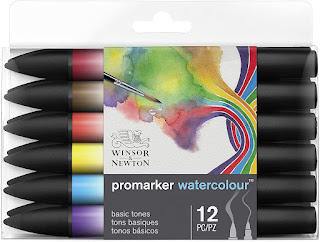This month I am reviewing items that will be perfect for capturing the essence of autumn color, which is a nice departure from October’s monochromatic Inktober series. Spooky and moody transitions to the brilliant and cozy shades of nature. This week I am going to review a few products that I have not used before: Windsor & Newton watercolor Promarkers, the Art-n-Fly Premium watercolor pad, and Canson’s Artist Series Mix Media pad.
Affiliate Disclaimer: For
full transparency, you should know that many of my links in my posts are
affiliate links. As an Amazon affiliate, I receive a small commission when
readers purchase items using my affiliate links. This helps me fund the blog
domain costs, and you will not be charged extra if you buy anything using my links.
 |
| W&N Promarker Basic tones set (image from Amazon.com) |
Windsor and Newton Watercolor Markers
I bought two sets of the Windsor & Newton watercolor
markers and two individual shades earlier this year. I have used them more for
coloring books than to make artworks with them. I have loved using them in my better
coloring books because they do not bleed through the paper as easily as alcohol
markers do. Here are the sets and single markers I have bought:
Landscape Set of 6 Amazon link: https://amzn.to/3w3mJ2I
Basic Tones Set of 12 Amazon link: https://amzn.to/3w7vp8r
Gamboge Hue individual Amazon link: https://amzn.to/3w6fEyy
Pale Rose individual Amazon link: https://amzn.to/3mxUd69
Compared to typical
brush pens with water-based ink, these markers put down more pigment, which
can take a lot more water than the more translucent brush pens. I have been
able to make washes by “drawing” in the wells of my porcelain paint pallet and
adding water, but this is a very wasteful endeavor if you are washing a large
area. In my opinion, the W &N watercolor markers are best used for travel
and plein air painting with small works of art. They give you the control of a
marker and work well with your water brushes (I mean the refillable ones with
water wells, not brush markers).
While these markers have excellent pigments and high-quality nibs, they are pricey. That comes with the Windsor & Newton name. That said, I have layered these with traditional watercolor and gouache paints, watercolor and InkTense pencils, brush markers, and dry media with very few problems. The colors mix well with one another, so you can get away with a basic color set at first and save some money. The markers are double ended with a finer bullet tip for details and a solid but flexible brush- like tip that can cover larger areas with some pressure. While the watercolor Promarkers look a lot like alcohol markers, they do not fill solid areas without streaking. You can create some lovely textures with them, but do not expect to get solid cartoon cell type of coloring out of them.
 |
| Art-n-Fly Premium Watercolor Pad (image from Amazon.com) |
Art-n-Fly Premium Watercolor Pad
I have talked about
the difference
between cotton rag and pulp watercolor papers in a past post where I went
into some detail, and I recommend reading that older post if you are
interested. I was interested in this Art-n-Fly Premium Watercolor Pad because it is 100% cotton paper, which is
hardier than pulp and can accept more wet washes and surface scrubbing. This watercolor
pad contains 15 sheets of cold-press acid-free 140 lb. paper that is glued on
two sides to ensure your work stays flat while you are painting and dries flat
for presentation. The back is a heavy cardboard that provides adequate support
for painting on the go, and the fold-over front can be tucked neatly behind the
pad to stay out of your way while working. The 9 x 12-inch size was only about
$17, which is much more affordable than Arches and Windsor & Newton
watercolor blocks of the same size and weight.
I tried the W & N markers on it, and I should warn you that this paper will suck the life out of them if you draw directly onto the dry paper. I doubt that is the suggested way to use the markers, but I wanted to try it out to see what happened. The paper takes traditional watercolor washes rather well, and you can “erase” areas with extra water without destroying the surface.
 |
| Canson Artist Series Mixed Media pad (image from Amazon.com) |
Canson Artists’ Mixed Media Pad
I have posted about the Canson XL mixed media pads previously
because I have used so many of them over the years, but Canson also makes a
higher quality Artist Series Mix Media pad
that I decided to test out for comparison. First and foremost, this pad has
heavier paper (148 lb. versus the 98 lb. XL paper) so it can endure a little
more surface scrubbing and water. The acid-free paper offers two surfaces: a
medium tooth front and finer back side. This means you can layer more dry media
and apply more water with your wet media, but you still have the smoother
surface on the reverse side that will work better for pen and ink and marker. I
bought the 8.5 X 5.5-inch size wire-bound pad to try out, but there are other
sizes available, including a hardback version that is great for preserving
finished works.
This pad is not glue bound, so there is a bit of warping
with water techniques, but the paper flattens nicely after it is dry. I would
normally use a bit of painter’s tape along the free edge to keep the page flat
as it dries, but I experimented with leaving it free, and there was no
permanent warping. While this is a pulp paper, you don’t get those dreaded
dingleberries as easily from the surface when you rework areas. I think I am
going to buy the Artist series from now on, after I use up the XL pads I
currently own.